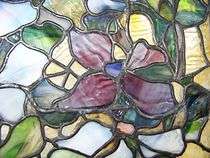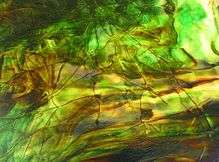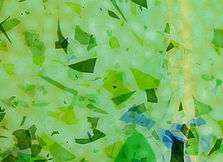Tiffany glass
Tiffany glass refers to the many and varied types of glass developed and produced from 1878 to 1933 at the Tiffany Studios in New York, by Louis Comfort Tiffany and a team of other designers, including Clara Driscoll.[1][2]
In 1865, Tiffany traveled to Europe, and in London he visited the Victoria and Albert Museum, whose extensive collection of Roman and Syrian glass made a deep impression on him. He admired the coloration of medieval glass and was convinced that the quality of contemporary glass could be improved upon. In his own words, the "Rich tones are due in part to the use of pot metal full of impurities, and in part to the uneven thickness of the glass, but still more because the glass maker of that day abstained from the use of paint".
Tiffany was an interior designer, and in 1878 his interest turned towards the creation of stained glass, when he opened his own studio and glass foundry because he was unable to find the types of glass that he desired in interior decoration. His inventiveness both as a designer of windows and as a producer of the material with which to create them was to become renowned.[3] Tiffany wanted the glass itself to transmit texture and rich colors and he developed a type of glass he called Favrile.
Types
Opalescent glass

The term "opalescent glass" is commonly used to describe glass where more than one color is present, being fused during the manufacture, as against flashed glass in which two colors may be laminated, or silver stained glass where a solution of silver nitrate is superficially applied, turning red glass to orange and blue glass to green. Some opalescent glass was used by several stained glass studios in England from the 1860s and 1870s onwards, notably Heaton, Butler and Bayne. Its use became increasingly common. Opalescent glass is the basis for the range of glasses created by Tiffany.[4]
Favrile glass
Tiffany patented Favrile glass in 1892. Favrile glass often has a distinctive characteristic that is common in some glass from Classical antiquity: it possesses a superficial iridescence. This iridescence causes the surface to shimmer, but also causes a degree of opacity. This iridescent effect of the glass was obtained by mixing different colors of glass together while hot.
According to Tiffany:
"Favrile glass is distinguished by brilliant or deeply toned colors, usually iridescent like the wings of certain American butterflies, the necks of pigeons and peacocks, the wing covers of various beetles."


Streamer glass
Streamer glass refers to a sheet of glass with a pattern of glass strings affixed to its surface. Tiffany made use of such textured glass to represent, for example, twigs, branches and grass.
Streamers are prepared from very hot molten glass, gathered at the end of a punty (pontil) that is rapidly swung back and forth and stretched into long, thin strings that rapidly cool and harden. These hand-stretched streamers are pressed on the molten surface of sheet glass during the rolling process, and become permanently fused.
Fracture glass
Fracture glass refers to a sheet of glass with a pattern of irregularly shaped, thin glass wafers affixed to its surface. Tiffany made use of such textured glass to represent, for example, foliage seen from a distance.
The irregular glass wafers, called fractures, are prepared from very hot, colored molten glass, gathered at the end of a blowpipe. A large bubble is forcefully blown until the walls of the bubble rapidly stretch, cool and harden. The resulting glass bubble has paper-thin walls and is immediately shattered into shards. These hand blown shards are pressed on the surface of the molten glass sheet during the rolling process, to which they become permanently fused.
Fracture-streamer glass


Fracture-streamer glass refers to a sheet of glass with a pattern of glass strings, and irregularly shaped, thin glass wafers, affixed to its surface. Tiffany made use of such textured glass to represent, for example, twigs, branches and grass, and distant foliage.
The process is as above except that both streamers and fractures are applied to sheet glass during the rolling process.
Ring mottle glass
Ring mottle glass refers to sheet glass with a pronounced mottle created by localized, heat-treated opacification and crystal-growth dynamics. Ring mottle glass was invented by Tiffany in the early 20th century. Tiffany's distinctive style exploited glass containing a variety of motifs such as those found in ring mottle glass, and he relied minimally on painted details.
When Tiffany Studio closed in 1928, the secret formula for making ring mottle glass was forgotten and lost. Ring mottle glass was re-discovered in the late sixties by Eric Lovell of Uroboros Glass. Traditionally used for organic details on leaves and other natural elements, ring mottles also find a place in contemporary work when abstract patterns are desired.
Ripple glass


Ripple glass refers to textured glass with marked surface waves. Tiffany made use of such textured glass to represent, for example, water or leaf veins.
The texture is created during the glass sheet-forming process. A sheet is formed from molten glass with a roller that spins on itself while travelling forward. Normally the roller spins at the same speed as its own forward motion, much like a steam roller flattening tarmac, and the resulting sheet has a smooth surface. In the manufacture of rippled glass, the roller spins faster than its own forward motion. The rippled effect is retained as the glass cools.
Drapery glass
Drapery glass refers to a sheet of heavily folded glass that suggests fabric folds. Tiffany made adundant use of drapery glass in ecclesiastical stained glass windows to add a 3-dimensional effect to flowing robes and angel wings, and to imitate the natural coarseness of magnolia petals.
The making of drapery glass requires skill and experience. A small diameter hand-held roller is manipulated forcefully over a sheet of molten glass to produce heavy ripples, while folding and creasing the entire sheet. The ripples become rigid and permanent as the glass cools. Each sheet produced from this artisanal process is unique.
Techniques for cutting Tiffany glass
In order to cut streamer, fracture or ripple glass, the sheet may be scored on the side without streamers, fractures or ripples with a carbide glass cutter, and broken at the score line with breaker-grozier pliers.
In order to cut drapery glass, the sheet may be placed on styrofoam, scored with a carbide glass cutter, and broken at the score line with breaker-grozier pliers, but a bandsaw or ringsaw are the preferred.
Locations and collections


Stained glass in situ
- Canada
- Ontario
- London – St Paul's Cathedral, four windows, two signed by Tiffany
- Montreal – Montreal Museum of Fine Arts, twenty windows signed by Tiffany
- Ontario
- Mexico
- Mexico City
- Historical Centre, Mexico City – Palacio de Bellas Artes, Stage "curtain" which is a stained glass foldable panel created out of nearly a million pieces of iridescent colored glass by Tiffany's in New York. .
- Mexico City
- United States
- California
- Mare Island, Vallejo – St. Peter's Chapel[5]
- Connecticut
- Florida
- Georgia
- Atlanta- All Saints' Episcopal Church[8]
- Macon – St. Paul's Episcopal Church
- Illinois
- Chicago –
- Macy's on State Street, formerly Marshall Field's
- Second Presbyterian Church on South Michigan Avenue
- Chicago –
- Indiana
- Indianapolis – Second Presbyterian Church
- Iowa
- Dubuque – St. Luke's United Methodist Church
- Kansas
- Topeka – First Presbyterian Church
- Kentucky
- Maryland
- Massachusetts
- Michigan
- Grand Rapids –
- Ladies Literary Club
- Temple Emanuel
- Grand Rapids –
- Missouri
- New Hampshire
- New Jersey
- Hackensack – Second Reformed Church
- Maplewood - Morrow Memorial United Methodist Church
- New Brunswick – Kirkpatrick Chapel at Rutgers, The State University of New Jersey[9][10]
- New York
- Albany – First Presbyterian Church of Albany[11]
- Albion – Pullman Memorial Universalist Church
- Auburn – Willard Chapel
- Briarcliff Manor – Congregational Church[12]
- Brooklyn –
- Brown Memorial Baptist Church and church house[13]
- Flatbush Reformed Church and church house
- First Unitarian Congregational Society and Rev. Donald McKinney chapel
- Irvington –
- Irvington Presbyterian Church
- Reading Room, Irvington Town Hall
- Lockport — First Presbyterian Church[14]
- Manhattan –
- Roslyn – Trinity Episcopal Church[16]
- Roxbury – Jay Gould Memorial Reformed Church
- Saugerties – St. Mary of the Snow, 36 Cedar Street
- Ohio
- Dayton –
- Westminster Presbyterian Church, 125 N. Wilkinson Street[17][18]
- Historic Woodland Cemetery & Arboretum, 118 Woodland Avenue[19]
- Dayton –
- Pennsylvania
- Franklin – St. John's Episcopal Church
- Montgomery Township – Robert Kennedy Memorial Presbyterian Church
- Philadelphia – Church of the Holy Trinity
- Philadelphia – First Presbyterian Church
- Pittsburgh – Calvary United Methodist Church
- Williamsport – Christ Community Worship Center, formerly the Presbyterian Church of the Covenant
- Tennessee
- Texas
- Virginia
- Washington
- Wisconsin
- California
Museums
See also
References
Notes
- ↑ Taylor, Kate (February 13, 2007). "Tiffany's Secret Is Over". New York Sun. Retrieved 2009-11-16.
- ↑ Kastner, Jeffrey (February 25, 2007). "Out of Tiffany's Shadow, a Woman of Light". New York Times. Retrieved 2009-11-16.
- ↑ Lee, Lawrence; Seddon, George and Stephens, Francis. Stained Glass, 1976, Spring Books ISBN 0-600-56281-6
- ↑ The use of the term opalescent is actually a misnomer. Opalescence actually refers to the quality of changing color under transmitted light, rather than the quality of having several colors present. A rare example of true opalescent glass is the Roman Lycurgus cup in the British Museum
- ↑ "Mare Island Historic Park Foundation". www.mareislandhpf.org. Retrieved 2015-10-05.
- ↑ John Davenport Window: Joseph Lauber
- ↑ Jesus and child (1916)
- ↑ "Stained Glass Windows".
- ↑ Rutgers, The State University of New Jersey — Kirkpatrick Chapel. "Stained Glass Windows". Retrieved 2 September 2013.
- ↑ DiIonno, Mark. "Di Ionno: At historic Rutgers chapel, stained glass is still shining" in The Star-Ledger (8 August 2012). Retrieved 2 September 2013.
- ↑ http://www.firstpresalbany.org/closer-look/closer-look.html
- ↑ Karen M. Sharman, ed., Glory in Glass: A Celebration of the Briarcliff Congregational Church, privately printed, NY: Briarcliff, 1996
- ↑ "Brown Memorial Baptist Church, Brooklyn" on the Untapped Cities website
- ↑ "First Presbyterian Church » Tiffany Windows". 1stpreslockport.org. Retrieved 2016-06-13.
- ↑ "Landscape Window". New-York Historical Society. Retrieved 17 December 2012.
- ↑ Trinity Church History
- ↑ "Westminster Presbyterian Church- Te Deum Window". Westminster Presbyterian Church. Retrieved 10 August 2015.
- ↑ "Westminster Presbyterian Church- Te Deum Window brochure" (PDF). Westminster Presbyterian Church. Retrieved 10 August 2015.
- ↑ "Dayton Convention & Visitors Bureau". Dayton Convention & Visitors Bureau. Retrieved 10 August 2015.
- ↑ http://www.stspeterandpaulbasilica.com/history
- ↑ http://www.trinitygalv.org/history/
- ↑ http://trinitystaunton.org/about-us/visiting/
- ↑ http://www.oshkoshmuseum.org/default.asp?title=Sawyer-Home-and-Grounds&contentID=17
- ↑ Haworth Art Gallery
- ↑ Hosmer Morse Museum website
- ↑ http://www.newcombartgallery.tulane.edu/tiffanywindow_new.html
- ↑ Neustadt Collection of Tiffany Glass
- ↑ http://www.nyhistory.org
- ↑ http://www.vmfa.museum/Collections/
Further reading
- Frelinghuysen, Alice Cooney (2006). Louis Comfort Tiffany and Laurelton Hall: an artist's country estate. New York: The Metropolitan Museum of Art. ISBN 1588392015.
External links
| Wikimedia Commons has media related to Tiffany glass. |
| Wikimedia Commons has media related to Tiffany lampshades. |
| Wikimedia Commons has media related to Tiffany stained glass windows. |